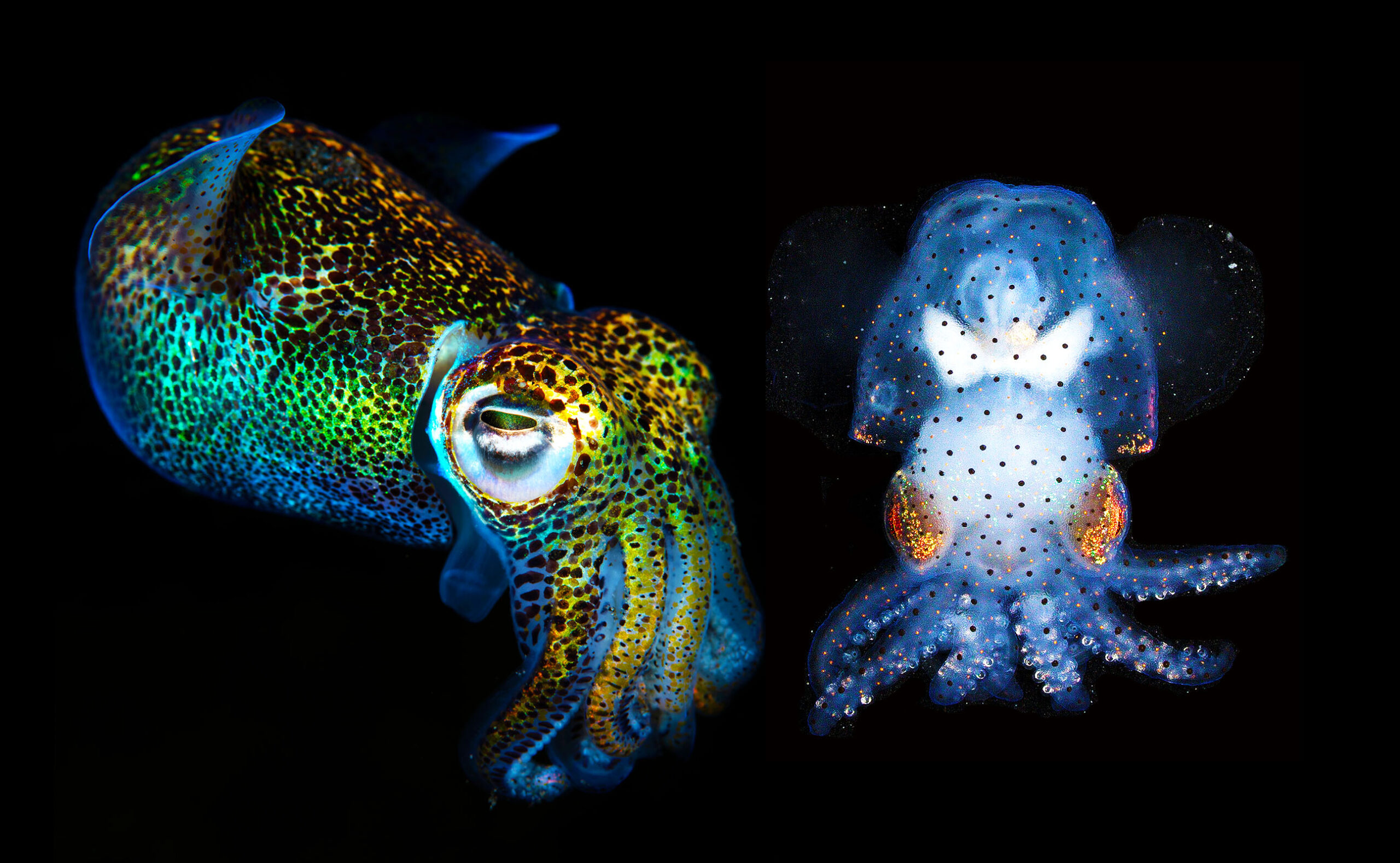Scientists have created a squid that is transparent so you can see inside while it’s alive.

A team of scientists has genetically engineered a transparent albino squid in the lab. A research team at the Marine Biology Laboratory (MBL) accomplished this remarkable feat using a strain of hummingbird short-tailed squid known as Euprymna berryi.
Published worldwide on June 20 in the journal Current Biology, this pioneering work is an important scientific advance.
Making transparent squid – what makes this so special?
As in science fiction, the team created a near-transparent creature. It is a living window into the nervous system of cephalopods. This is a group of incredibly clever and mysterious sea creatures that include squid, octopus and cuttlefish.
It is also the first time scientists have been able to breed genetically modified cephalopods over multiple generations. E. berryi now shows tremendous potential to become a model organism for studies focusing on the neurobiology of cephalopods, among other types of research.
MBL Senior Scientist Joshua Rosenthal, who led the joint study with MBL Hibbitt Fellow Caroline Albertin, emphasized the importance of this development.
“Unlike other invertebrates, there is a lot of incredibly interesting biology surrounding cephalopods,” said Rosenthal. “Now we have model cephalopods that can probe biological functions at much higher resolution than before.”
Why Scientists Chose Cephalopods for Study
Cephalopods are fascinating creatures. They have a much more complex nervous system and behavior than most invertebrates. They are quick to learn and can remember complex tasks. They can learn by solving puzzles, using tools, and even just watching others.
Cephalopods can change color in the blink of an eye to blend in with their environment. They use their arms and tentacles to interact with the environment. According to another recent study by MBL, these organisms can adapt to cold environments by making significant adjustments to their RNA.
The study of cephalopods is particularly difficult.
However, studying cephalopods is fraught with difficulties. In contrast to extensive studies in fruit flies and mice, the lack of viable model organisms has limited our understanding of the genetics of cephalopods.
However, this new study introduces E. berryi as an interesting candidate. It is easy to breed in the lab and can be genetically modified. This becomes a game changer in cephalopod research.
Albertin, co-author of the study, is optimistic about the possibilities. “The ability to directly and accurately test gene function in model cephalopods will be an important tool for understanding many facets of their exciting and unique biology, as they allow us to study the functions that make cephalopods special,” she said. . .
How Transparent Squids Are Made
To create these transparent cuttlefish, the team used CRISPR-Cas9 genome editing to inactivate two pigment enzymes in E. berryi’s gene. Then, Cris Niell and Eugene of the University of Oregon and Ivan Soltesz of Stanford University investigated brain activity in deformed squid.
They did so by injecting a fluorescent dye into the optic nerve. This dye glows whenever it detects calcium. It is a substance that the brain releases when it is active.
Researchers exposed squid to a variety of images. This activated the optic nerve and made the dye bright. This entire process was captured using a microscope. When the same technique was attempted with a regular squid, the dye was difficult to see due to the color of the skin.
Explaining the implications of this discovery, Rosenthal said it “allows us to look at gene function and the cephalopod brain in a way that has never been seen before.”
It opens new avenues for researchers interested in studying how signals travel through the cephalopod brain. They can now breed transparent squid and conduct similar experiments with calcium-activated dyes.
More discoveries from the transparent squid experiment
This study also revealed new aspects of E. berryi biology. When they deactivated the first pigment gene, known as TDO, they expected to produce an albino squid.
This was a reasonable assumption since they did so with other squid species. In the 2020 study, they used the Doryteuthis species.
Surprisingly, the resulting E. berryi progeny still showed pigmentation. Scientists then discovered that a second enzyme called IDO also creates pigment.
This was a previously unknown feature in cephalopods. The reason for E. berryi to have two enzymes that seemingly do the same thing currently remains a mystery.
The team hopes to get more scientists involved in this research effort.
The study’s leaders, Rosenthal, Albertin, and their team have high hopes that other scientists will dive deeper into exploring the biology of E. berryi. They want to see the albino squid shared with the wider research community. This will help unravel more of the seemingly endless mysteries of cephalopod biology.
“We want to see these animals shared with the research community,” said Rosenthal. Cephalopods contain a treasure trove of biological novelties. We want to see people ask thought-provoking questions and use them to produce novel results.”
In summary, the creation of this genetically engineered transparent squid, an albino strain of Euprymna berryi, is a significant leap forward in our understanding of cephalopods. This new version of the hummingbird short-tailed squid allows researchers to study this intriguing marine animal in a way never before possible.
The research team’s hope is that this will stimulate further research and provoke thought-provoking questions. This will ultimately help all of us better understand the wonderful world of cephalopods.
More about squid
Cuttlefish are fascinating creatures and belong to the Cephalopodidae family, which also includes octopuses, cuttlefish and nautilus. They are known for their unique appearance.
Cuttlefish are characterized by a soft body and elongated shape, a head surrounded by individual arms, and two long tentacles.
Here’s what we know about squid.
Diversity and Scale
There are about 300 known species of squid that vary greatly in size. The smallest squid, the pygmy squid, is less than an inch long, while the largest species, the giant squid, can reach up to 46 feet in length. The vampire squid is another well-known species.
Anatomy
Cuttlefish have a soft, flexible body covered with a thin layer of skin. Some species have hard, feather-like structures called pens under the skin. It has a sharp beak made of keratin, the same substance as human fingernails, which it uses to catch and kill prey.
arms and tentacles
Squids have 10 appendages. 8 short arms and 2 long tentacles. The tentacles are usually used to capture prey and are guided into the mouth with the help of short arms.
ink
Most squids have ink sacs that can eject clouds of dark ink to confuse predators and allow them to quickly escape.
movement
Cuttlefish are excellent swimmers. They are driven by jet propulsion. Water is sucked into the mantle cavity and then forced out through a funnel-like structure, pushing it back.
Camouflage
Many squid have the ability to change color and even texture thanks to special skin cells called chromatophores. This ability aids in camouflage, communication, and hunting.
eye
Cuttlefish have highly developed eyes similar to human eyes. This allows you to see well in both bright and dark conditions.
Intellect
Cuttlefish are among the most intelligent invertebrates. Some species exhibit complex behaviors such as problem solving and tool use. This allows them to better adapt to climate change.
diet
Cuttlefish are carnivorous and feed mainly on fish, crustaceans and other cuttlefish. They are also prey for a variety of species, including sharks, other squid, seabirds, and whales.
reproduction
Squid reproduction involves male cuttlefish storing sperm packets in the female’s body. The female then lays eggs and attaches them to the seabed or other substrate. Most squid die after breeding.
bioluminescence
Some squid species can glow. This is a phenomenon known as bioluminescence, which they use to communicate, attract prey, or ward off predators.
symbiosis
Some squid species, such as the Hawaiian short-tailed squid, have a symbiotic relationship with bioluminescent bacteria that aid in their camouflage.
Information can vary greatly between squid species. Not all squid have the characteristics mentioned above. Additionally, scientists and researchers continue to make new discoveries about squid and their behavior.
More about CRISPR-Cas9 genome editing
CRISPR-Cas9, which stands for “Clustered Regularly Interspaced Short Palindromic Repeats and CRISPR-Associated Protein 9”, is an innovative tool in the field of genetics. MBL scientists have used this method to create transparent squid.
Derived from defense mechanisms used by bacteria, this technique has been applied to editing the genome, the complete set of genetic material present in a cell or organism. Here’s what we know about CRISPR-Cas9.
Mechanism – The process by which transparent squid is made
CRISPR-Cas9 works by utilizing a guide RNA (gRNA) to locate a specific sequence of DNA within the genome. The guide RNA pairs with the Cas9 protein and essentially guides it to the right place in the DNA.
Once in the right place, the Cas9 proteins act as a pair of ‘molecular scissors’ to cut the DNA at the designated spot. When DNA is cut, the cell’s own repair machinery fixes the break. This can introduce changes (mutations) to the sequence. Scientists can also precisely alter genetic information by providing a template for the repair process.
genome editing
The power of CRISPR-Cas9 is that it allows scientists to add, remove or change specific parts of an organism’s DNA sequence, providing a level of precision, efficiency and flexibility previously unavailable in genetic engineering. This has broad implications in fields such as medicine, agriculture, and basic biological research.
Applications (Other than making transparent squid)
Potential applications for CRISPR-Cas9 include treating genetic diseases, generating disease-resistant plants, combating pests, and eliminating insect-borne diseases such as malaria. In research, scientists can explore the function of different genes by creating organisms in which genes have been altered or removed.
Ethical considerations
While the potential benefits of CRISPR-Cas9 are enormous, their use also raises important ethical considerations. For example, changes to the human germline (e.g., eggs or sperm) may be passed on to future generations, raising concerns about unexpected consequences. There is also the potential for misuse, such as creating “designer babies” with certain genetic traits.
future prospects
As of last update in September 2021, research is ongoing to improve technology, minimize off-target effects (unintended DNA modifications), improve delivery methods, and address the ethical implications of genome editing.
In summary, CRISPR-Cas9 is a powerful tool that has revolutionized genetic research, offering the potential to address issues ranging from genetic diseases to food security. But it also raises important ethical questions for society to address.
#Scientists #created #squid #transparent #alive





